What Flour to Feed Sourdough Starter
Learn how to make a beginner sourdough starter at home. All you need is flour, water and a little bit of patience. Before you know it, you'll have your very own bubbly, active starter ready to make THE BEST s ourdough bread, sourdough focaccia and more!
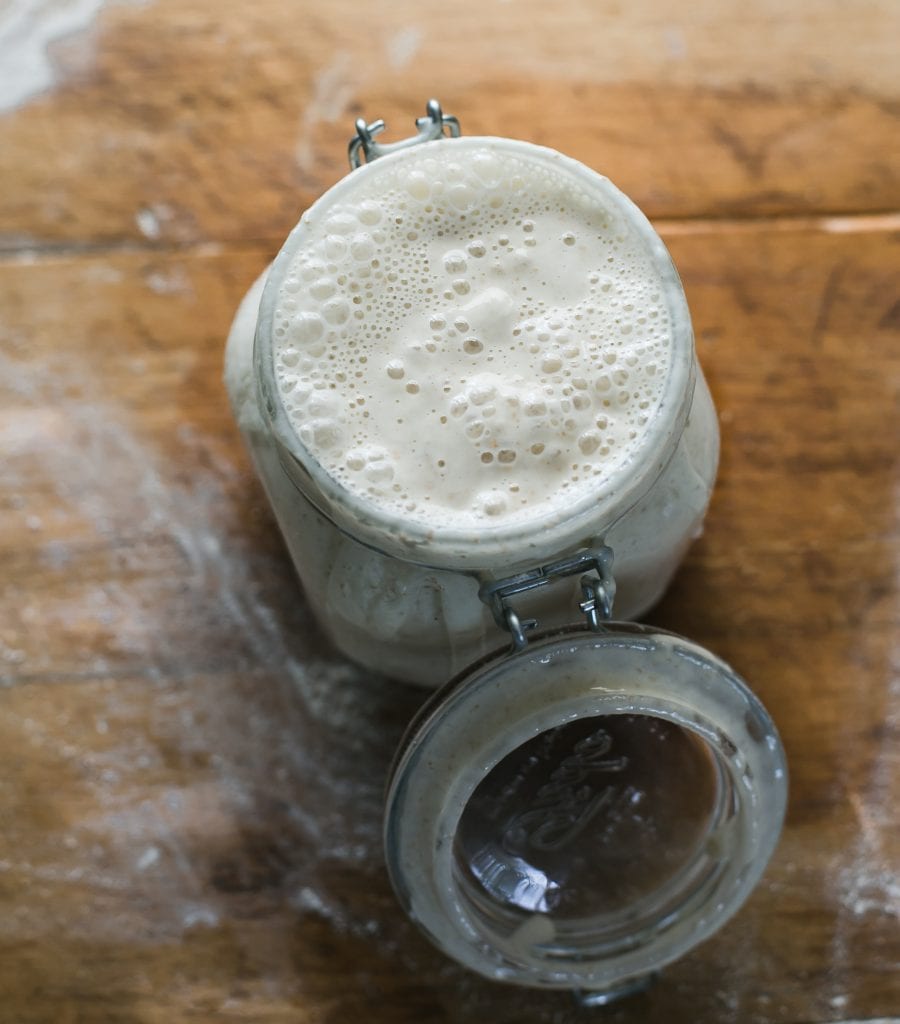
Looking to bake incredible sourdough bread? First: you'll need a sourdough starter. Without it, your bread won't rise. It's the absolute heart and soul of sourdough baking. Creating one from scratch is not hard to do. However, the process can seem intimidating (especially for beginners). Let's change that. Adapted from my book Artisan Sourdough Made Simple, I will demystify and simplify the process step-by-step.
Once your starter is established, it can be used for a wide variety of sourdough bread recipes including this scrumptious sourdough bread with olive oil (most popular recipe on my blog!), my sourdough focaccia, easy sourdough sandwich bread, light whole wheat sourdough, homemade sourdough bagels and so much more!
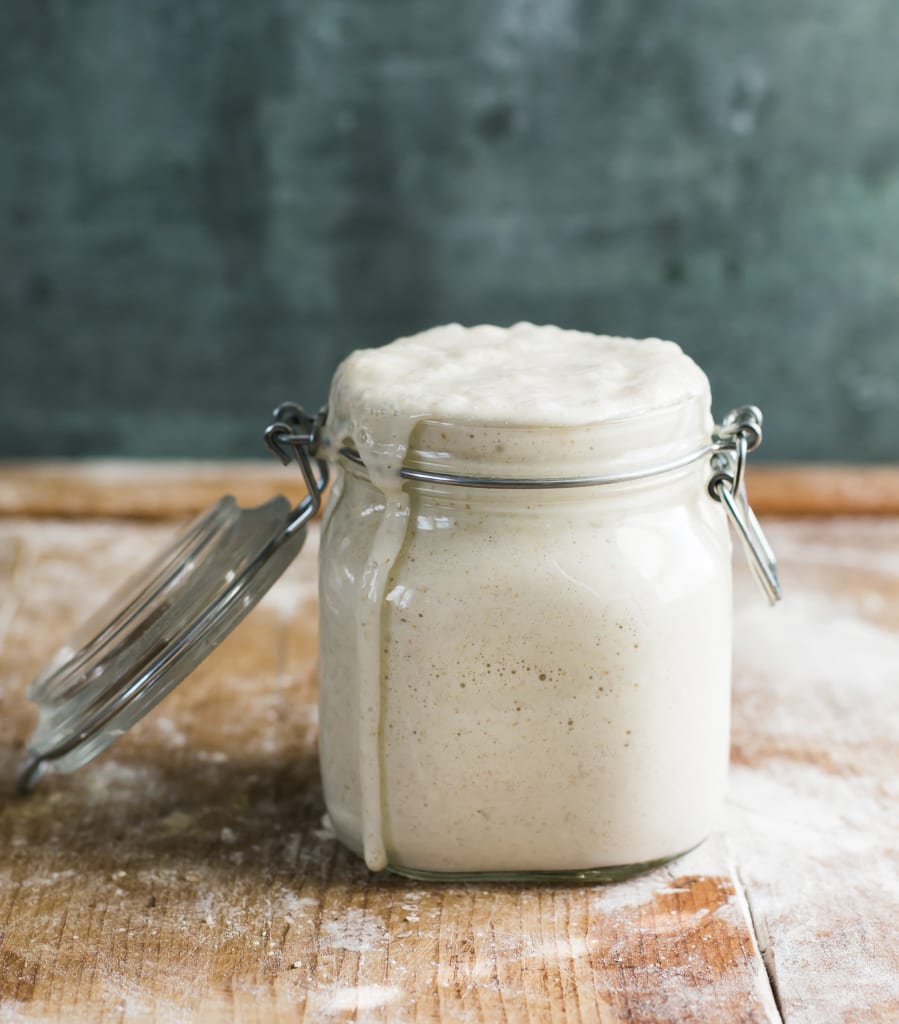
What is a Sourdough Starter?
Sourdough is more than just a recipe; it's an understanding. So before we dive in, let's define. Simply put: a sourdough starter is a live fermented culture of fresh flour and water. Once combined, the culture will begin to ferment and cultivate the natural yeasts found in our environment. A small portion is added to your bread dough to make it rise. Commercial yeast IS NOT required.
Sounds a bit weird, right? Of course it does. And it should. Know this: natural "wild" yeast is all around us. It can be found in a bag of flour, in the air, on your hands etc.. Just because you can't see it, doesn't mean it's not there and doing its thing. It's like magic.
How Long Will It Take?
To create a sourdough starter from scratch, the overall process should take about 7 days (or more) from start to finish- it's not instant. First, you'll create the starter with whole wheat flour to jumpstart fermentation. Then, you'll continue to feed it with regular white flour to cultivate the wild yeasts and friendly bacteria.
When Will it Be Ready To Use?
Your starter is ready when it has doubled in size, with plenty of bubbles on the surface and throughout the culture.
NOTE: It's not uncommon for it to take up to two weeks or more for the starter to become active. It all depends. I know this timeframe sounds a bit vague, but growing yeast in a jar (that's basically what you're doing) can be unpredictable at times. Please be patient if the process takes time for you- it's normal.
Is it Difficult to Do?
Absolutely not! In short: you're basically adding flour and water to a jar, feeding it with more flour and water over time, and then waiting for it to become bubbly and double in size. That's it. Most of your time involvement is hands-off. Can I ask you a favor though?
Don't overthink it.
There's a lot of sourdough information out there, and you will fall down a major rabbit hole if you start poking around. Just stick to this tutorial for now and follow the steps.
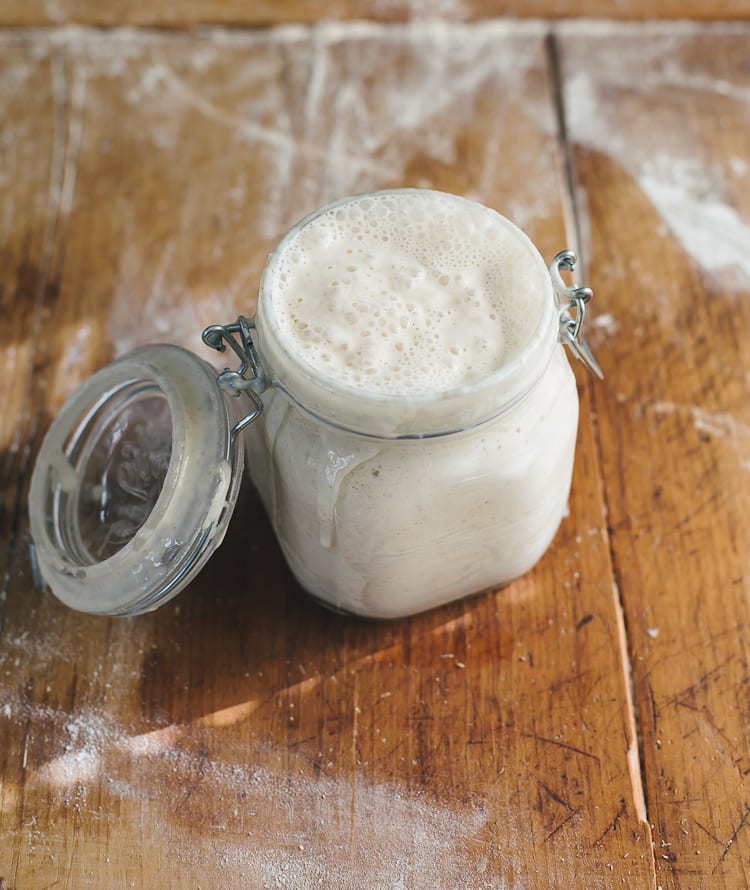
Beginner Sourdough Starter Recipe
You will Need:
Supplies
- 3/4 L jar (I use this one)
Ingredients
To create the starter:
- 60 g (1/2 cup) whole wheat flour
- 60 g (1/4 cup) water
To feed the starter each day (Day 3-7):
- 60 g (1/2 cup) unbleached all purpose flour or bread flour
- 60 g (1/4 cup) water
Tip: Use regular, unbleached all purpose flour for best results- skip organic. The enzymes are different which can hinder the rising process the first time around. I use either KAF, Trader Joe's or Whole Foods. Filtered water or tap water is fine. Use the latter if you know it's mostly chemical/chlorine free.
Day 1: Make the Starter
Combine 60 g (1⁄2 cup) of whole wheat flour and 60 g (1⁄4 cup) of warm water in a large jar.
Mix with a fork until smooth; the consistency will be thick and pasty. If measuring by volume, add more water to thin out the texture if needed. Cover with plastic wrap or a lid, and let it rest in a warm spot, about 75-80 F for 24 hours.
Tip: Looking for a warm spot? Place your starter on a cookie sheet inside the oven (turned off) with the light on for a few hours (but not overnight- it might become too warm). You can also use a proofing box set to your desired temperature, or a microwave with the door ajar and the light on.
Day 2: Got Bubbles?
Today, you're going to check if any small bubbles have appeared on the surface.
Bubbles indicate fermentation, which is what you want! However, it's okay if you don't see anything right away; the bubbles might have appeared and dissolved overnight while you were sleeping. This happens quite often.
You do not have to do anything else right now. It does not need any flour or water. Just rest the starter in your warm spot for another 24 hours.
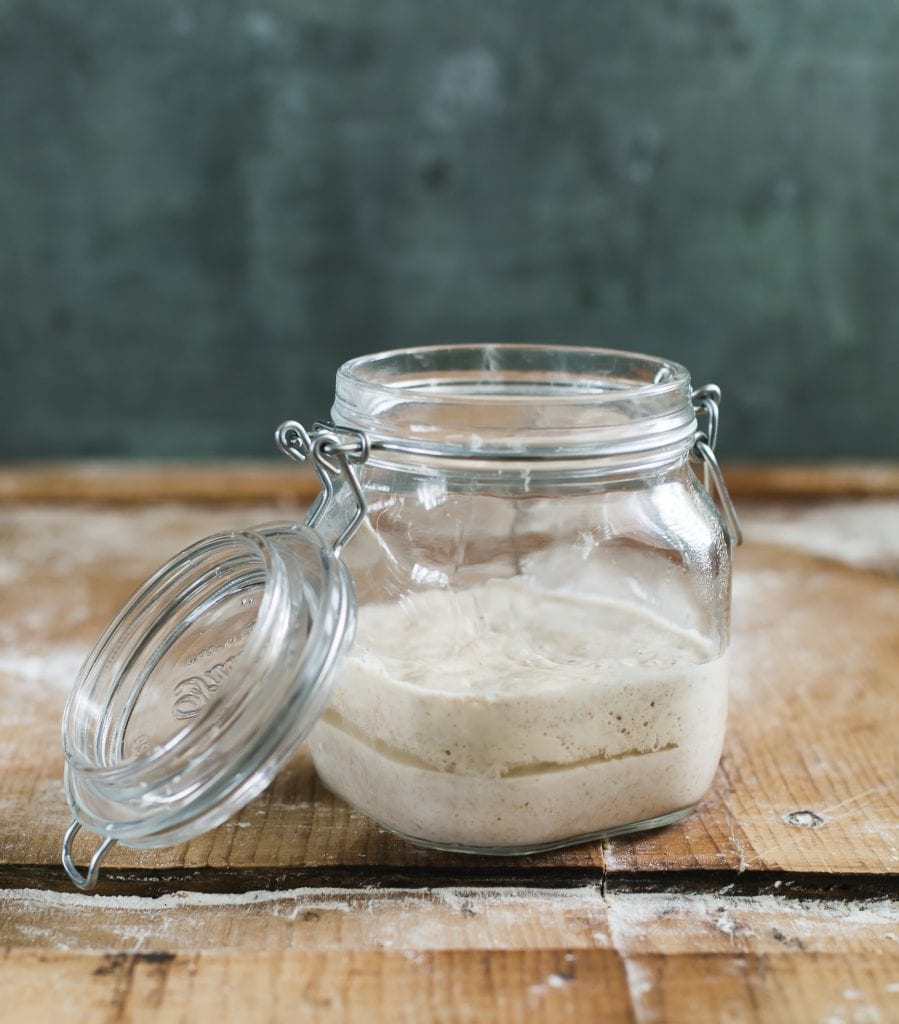
Day 2 (Con't): What's that brown liquid?
During the creation process, and even after your starter has been established, a dark liquid might appear on the starter (the image above shows the liquid in the middle of the starter- it's usually found on the surface).
This liquid is called "hooch" and is an indication that your starter needs to be fed. It also has a very stinky smell, similar to rubbing alcohol or gym socks. This is normal. Don't freak out. Any time you see this liquid, it's best to pour it off, along with any discolored starter present. However, on Day 2 just leave the hooch alone; you can get rid of it tomorrow when you start the feedings.
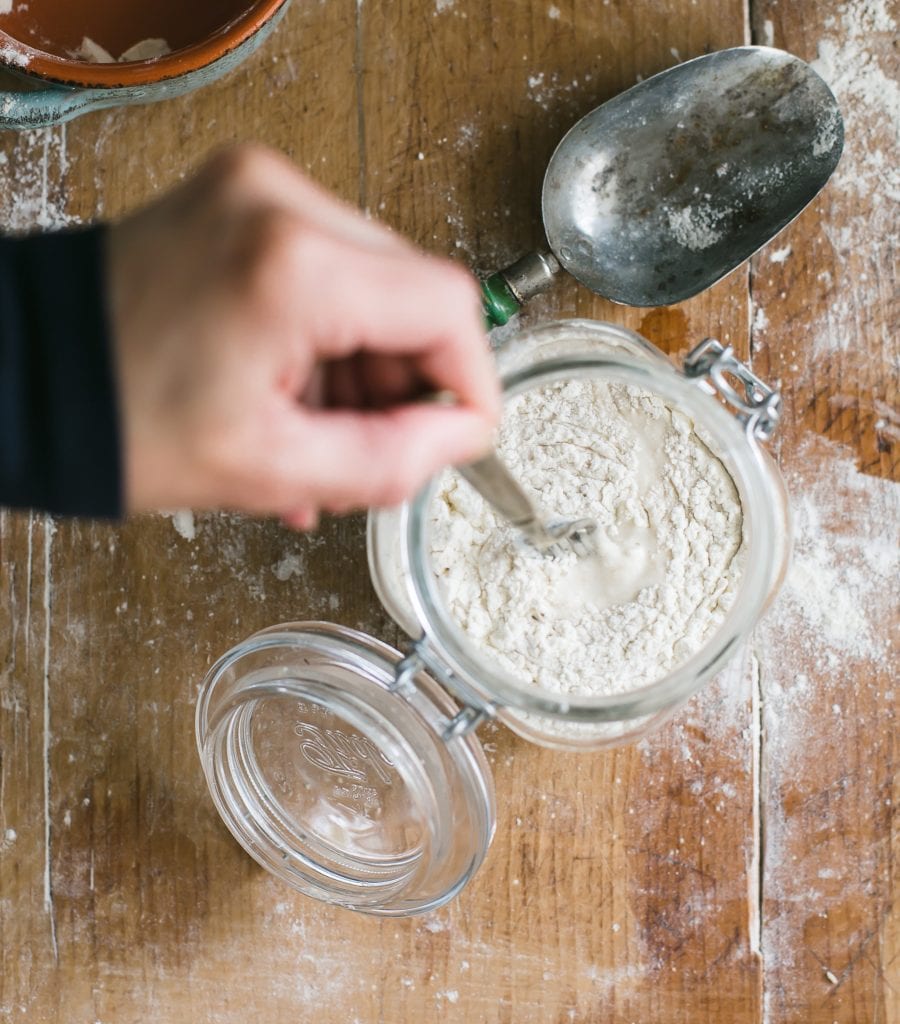
Day 3: Feed Your Starter
Whether bubbles are visible or not, it's time to start the feeding process.
Remove and discard approximately half of your starter from the jar (you should have about 60 g left). Use a spoon. The texture will be very stretchy. Add 60 g (1⁄2 cup) of all-purpose our and 60 g (1/4 cup) of warm water. Mix with a fork until smooth.
The texture should resemble thick pancake batter or plain yogurt (not Greek) at this point so add more water as needed. Cover and let rest in your warm spot for another 24 hours.
DAYS 4, 5, & 6: Keep on Feeding!
Repeat the same feeding process as outlined on Day 3:
Remove and discard half of the starter, and feed it with 60 g (1⁄2 cup) of all-purpose flour and 60 g (1/4 cup) of warm water. As the yeast begins to develop, your starter will rise, and bubbles will form on the surface and throughout the culture.
When the starter falls, it's time to feed it again.
Tip: Place a rubber band or piece of masking tape around the jar to measure the starter's growth as it rises.
Day 7: A Sourdough starter is born!
By now, your sourdough starter should have doubled in size.
You should see plenty of bubbles, both large and small. The texture will now be spongy, fluffy, and similar to roasted marshmallows (think: s'mores). It should also smell pleasant and not like stinky gym socks. If these conditions are met, your starter is now active.
The very last step is to transfer your sourdough starter to a nice, clean jar. In keeping with tradition, you can also name it (and please do!). My starter is called Dillon after my oldest boy and it's bright and bubbly, just like he is ;)
Now you're ready to bake! Start with my beginner sourdough bread recipe- you're going to love it!
What's Next? Read These Posts.
- Sourdough Bread Recipe (reader favorite!)
- Feeding Sourdough Starter: My Best Tips & Tricks
- Troubleshooting Your Sourdough Starter
A Few Tips for Ongoing Care…
So you've created a sourdough starter! Now what?
Just like any living creature, it must be kept alive with regular feedings to maintain its strength. If your starter is not strong, your bread will not rise. Caring for your starter is much easier than you'd think, and certainly won't take hours of your time.
Note: You will need to feed your starter every time prior to making bread dough and to maintain it (keep it alive).
How to Feed a Sourdough Starter
Feeding Routine:
- Begin by removing and discarding about half of your starter.
- Replenish what's left in the jar with fresh all purpose flour and water.
- Cover loosely, and let it rise at room temperature until bubbly and double in size. Once it falls, the bubbles will become frothy and eventually disappear. Then you'll know it's time to feed your starter again.
- Feed your starter everyday if it's stored at room temperature. If you keep it in the fridge, feed it once a week.
PS: If you miss a feeding, don't worry- your starter is not going to die. It might look ugly (and smell horrendous) but it usually just needs a few feedings to perk back up.
When is Your Sourdough Starter Ready To Use?
Your starter is ready when it shows all of the following signs:
- bulk growth to about double in size
- small and large bubbles on the surface and throughout the culture
- spongy or fluffy texture
- pleasant aroma (not reminiscent of nail polish remover/gym socks/rubbing alcohol)
If you're having trouble spotting the signs, don't forget to place a rubber band around the base of the jar to measure the starter's growth.
You can also try the float test mentioned above: Drop a small dollop of starter into a glass of water. If it floats to the top, it's ready to use.
How to Store Your Sourdough Starter
Once your starter is established, you have two storage options to consider.
At Room Temperature: If you bake often—let's say a few times a week—store your starter at room temperature. This will speed up fermentation, making the starter bubbly, active, and ready to use faster. Room temperature starters should be fed one to two times a day, depending on how quickly they rise and fall.
In the Fridge: If you don't bake that often, store your starter in the fridge covered with a lid. You'll only need to feed it about once a week or so to maintain its strength when not in use (you can just feed it cold and then pop it back in the fridge right afterwards; no need to warm it up first). When you are ready to make dough, feed your starter at room temperature as needed, to wake it back up.
**TIP** For more info on sourdough starters please read Feeding Sourdough Starter: My Best Tips & Tricks.
Sourdough Starter Faqs
1.) Can sourdough starter be made with all purpose flour only?
Yes. All purpose flour is easy to find, inexpensive and reliable for starter growth.
2.) Can sourdough starter be made with whole wheat, spelt flour or rye flour only?
Yes. Because whole grain flour absorbs more water than all purpose flour, adjust the texture with additional water if it's too thick.
3.) Can sourdough starter be made with bread flour only?
Yes. Adjust the texture with additional water if it's too thick.
4.) Can sourdough starter be made with bleached flour?
Yes. But it's not recommended. The chemicals can throw off the rising process. However, some readers have reported success with bleached flour. Your choice!
5.) I only have organic flour. Will the recipe still work?
It might. To clarify: organic flour is not bad to use. The enzymes are just a bit different. This means the overall process might take longer than indicated. I recommend using all purpose flour instead because it's more predictable (and less expensive!).
6.) Why do you use whole wheat flour in the beginning of the recipe? And then switch to all purpose flour for the feedings?
Whole wheat flour is used to jumpstart the fermentation process. If you do not have whole wheat flour, just use all purpose flour instead. The starter will be fine. I switch to all purpose flour for the feedings because it's reliable, inexpensive and practical for everyday baking (remember, a portion of your starter is removed, discarded, or used for something else).
7.) Why do you remove and discard a portion of the starter before feeding it?
8.) Can I use the sourdough discard from Day 1-7 for something else?
In the beginning, I typically don't recommend using the discard (it's usually really smelly and discolored). I recommend using the discard after the starter has been established. However, everyone will have a different experience with this. If it looks good- use it!
For more info please read, Sourdough Discard 101: Recipes & Faqs Answered.
9.) Is it bad to switch flours halfway through the feeding process?
If your starter is used to one type of flour, and then you swap it out for something else, just give it time to adjust. It might react immediately (in a good way!) or it might be sluggish at first and then eventually perk up.
For more info please read, Feeding Sourdough Starters: My Best Tips & Tricks.
Description
Looking for an easy, sourdough starter recipe for beginners? Adapted fromArtisan Sourdough Made Simple,follow my no-nonsense guide for practical tips, tricks, and ongoing care- anyone can do it.
Note: Once your starter is established, use it to make my sourdough bread.
- 1 x (5lb) bag all purpose flour (I use either KAF, Trader Joe's, or Whole Foods)
- 1/2 cup (60g) whole wheat flour (I use KAF whole wheat)
- Water (preferably warm around 85F )
Tips:
- The overall process typically takes 7 days, if the temperature is warm enough. However, it can take up to 2 weeks or more for a strong starter to become established. Please be patient. Find a warm spot for your starter to rise (see tip in recipe below), and use warm water in your feedings (if necessary) to give the fermentation a boost.
- Only a small amount of whole wheat flour is used to jumpstart the fermentation process. If you don't want to commit to a large bag, smaller bags are available in most grocery stores. Alternatively, you can use all purpose flour only.
- You will also need one large 3/4 L jar, or something of similar size (I use this one.).
Day 1: Combine 60 g (1⁄2 cup) of whole wheat flour and 60 g (1⁄4 cup) of warm water in a large jar. Mix with a fork until smooth; the consistency will be thick and pasty. If measuring by volume, add more water to slightly thin out the texture if necessary. Cover with plastic wrap, reusable wax wrap, or a lid and let it rest in a warm spot, about 75-80 F, for 24 hours. Temperature is important.
TIP: Looking for a warm spot? Place your starter on a cookie sheet inside the oven (turned off) with the light on for an hour or two (it can get hot in there, so keep you eye on it!). Center rack is best. You can also use a proofing box set to your desired temperature, or a microwave with the door ajar and light on.
Day 2:Check to see if any bubbles have appeared on the surface. If you don't see anything, it's okay. The bubbles might have appeared and dissolved overnight while you were sleeping. You don't have to do anything else now. Rest the starter for another 24 hours.
TIP: During the creation process, and even after your starter has been established, a dark liquid might appear on the surface and throughout the culture. It has a very stinky smell, similar to rubbing alcohol or gym socks. This liquid is called "hooch" and is an indication that your starter needs to be fed. It's normal. Any time you see this liquid, it's best to remove it along with any discolored starter present. However, on Day 2 just leave the hooch alone. You can remove it tomorrow when you start the feedings.
Day 3: Remove and discard approximately half of your starter from the jar (you should have 60 g left). The texture will be very stretchy. Add 60 g (1⁄2 cup) of all-purpose flour and 60 g (1/4 cup) of warm water to the jar. Mix with a fork until smooth. The texture should resemble thick pancake batter or plain yogurt at this point. Cover and let rest in your warm spot for another 24 hours.
Days 4, 5 & 6: Continue feeding your starter: remove and discard about half and add 60 g flour + 60 g warm water each day.
As the yeast begins to develop, your starter will rise, and bubbles will form on the surface and throughout the culture. When the starter falls, it's time to feed it again.TIP: Place a rubber band or piece of masking tape around the jar to measure the starter's growth as it rises.
Day 7: By now, your starter should have doubled in size. You should see plenty of bubbles, both large and small. The texture will be spongy, fluffy, and similar to roasted marshmallows (think: s'mores). It should smell pleasant, and not link stinky like gym socks. If these conditions are met, your starter is now active and ready to use!
Please keep in mind, if your starter is not ready at this point which is quite common due to temperature issues (too cold), timing, and other factors, continue the feeding it for 1-2 weeks or more. Be patient!
The very last step is to transfer your starter to a nice, clean jar. In keeping with tradition, you can also name it and please do! My starter is called Dillon, after my oldest boy.
At a glance, your overall daily schedule with measurements should look like this:
- Day 1: 60 g flour + 60 g water = 120 g starter
- Day 2: Do nothing
- Day 3: Remove & discard half of the starter/ 60 g starter + 60 g flour + 60 g water = 180 g starter
- Day 4: Remove & discard half of the starter/ 90 g starter + 60 g flour + 60 g water = 210 g starter
- Day 5: Remove & discard half of the starter/ 105 g starter + 60 g flour + 60 g water = 225 g starter
- Day 6: Remove & discard half of the starter/ 112.2 g starter + 60 g flour + 60 g water = 232.5 g starter
- Day 7: Remove & discard half of the starter/ 116.25 g starter + 60 g flour + 60 g water = 236.27 g starter
Wondering if your starter is ready to use?
When your starter is fully active, do the float test. Feed your starter, wait for it to double in size, and then drop a teaspoon of bubbly starter into a jar of water; if it floats to the top it's ready to use.
Storage Options
If you bake often, store your starter at room temperature (feed it 1x-2x a day to keep it active). If you plan to bake only once in a while, store it in the fridge to preserve its strength (feed it 1x a week). When storing your starter in the fridge, there's no need to bring it to room temperature first before feeding it. Just give it some flour and water and pop it back in the fridge.
Keywords: sourdough, sourdough starter, beginner sourdough starter, recipe, easy, sourdough bread
Source: https://www.theclevercarrot.com/2019/03/beginner-sourdough-starter-recipe/
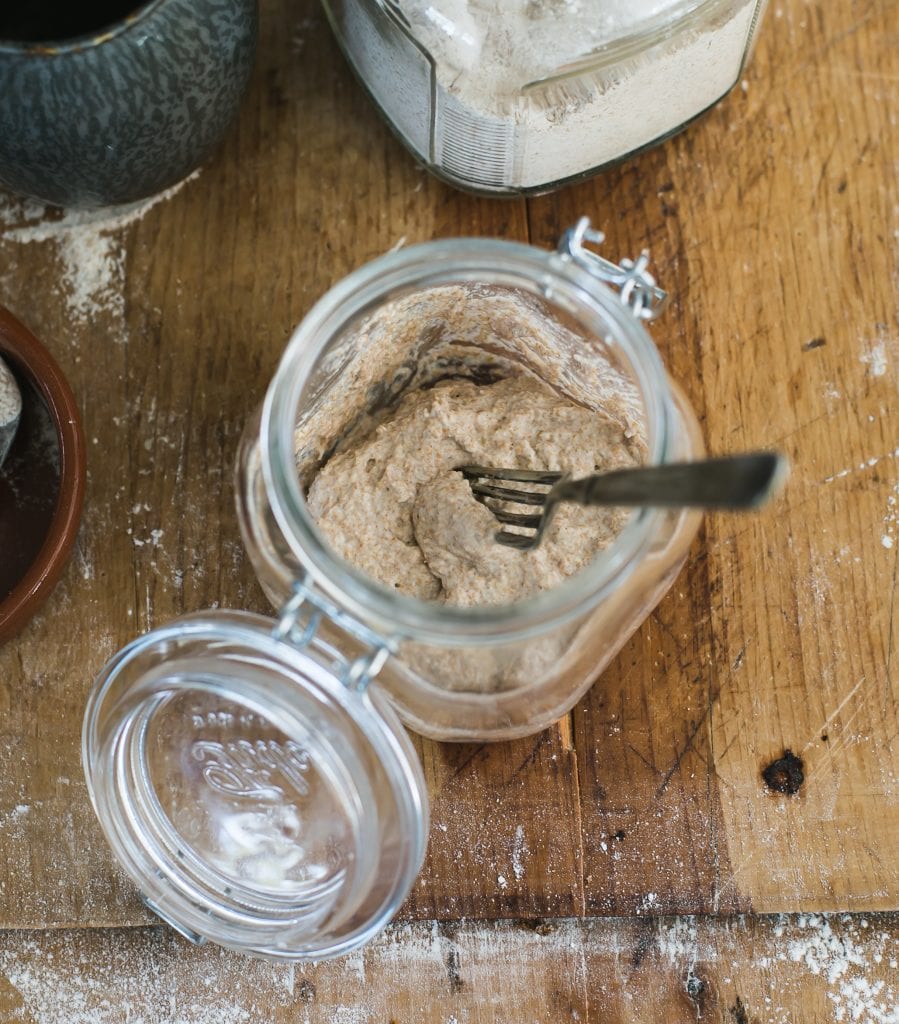
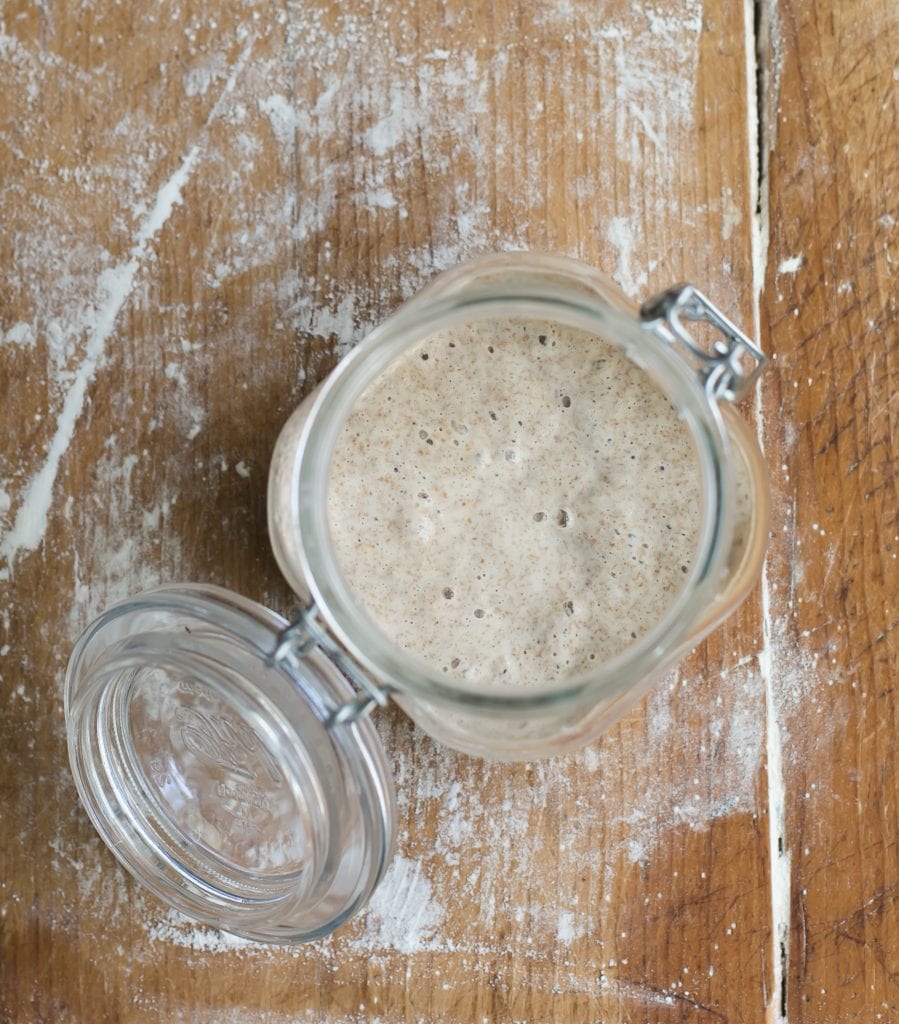
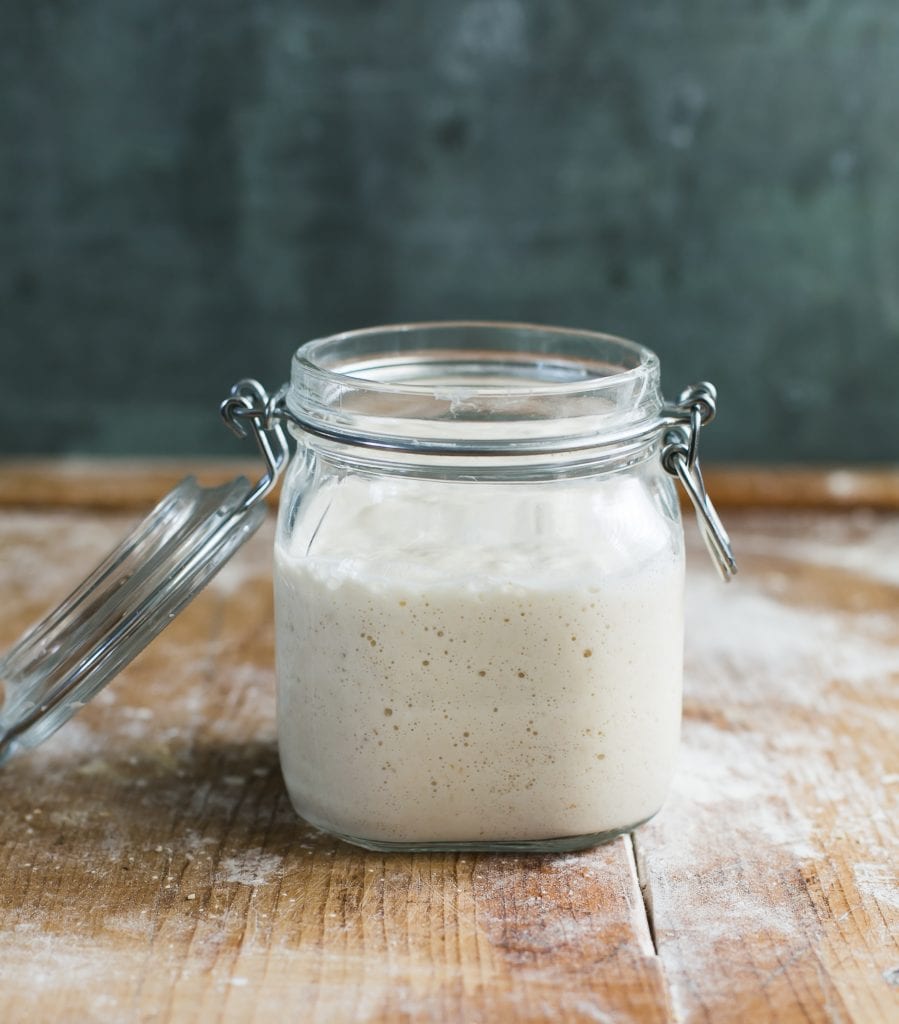
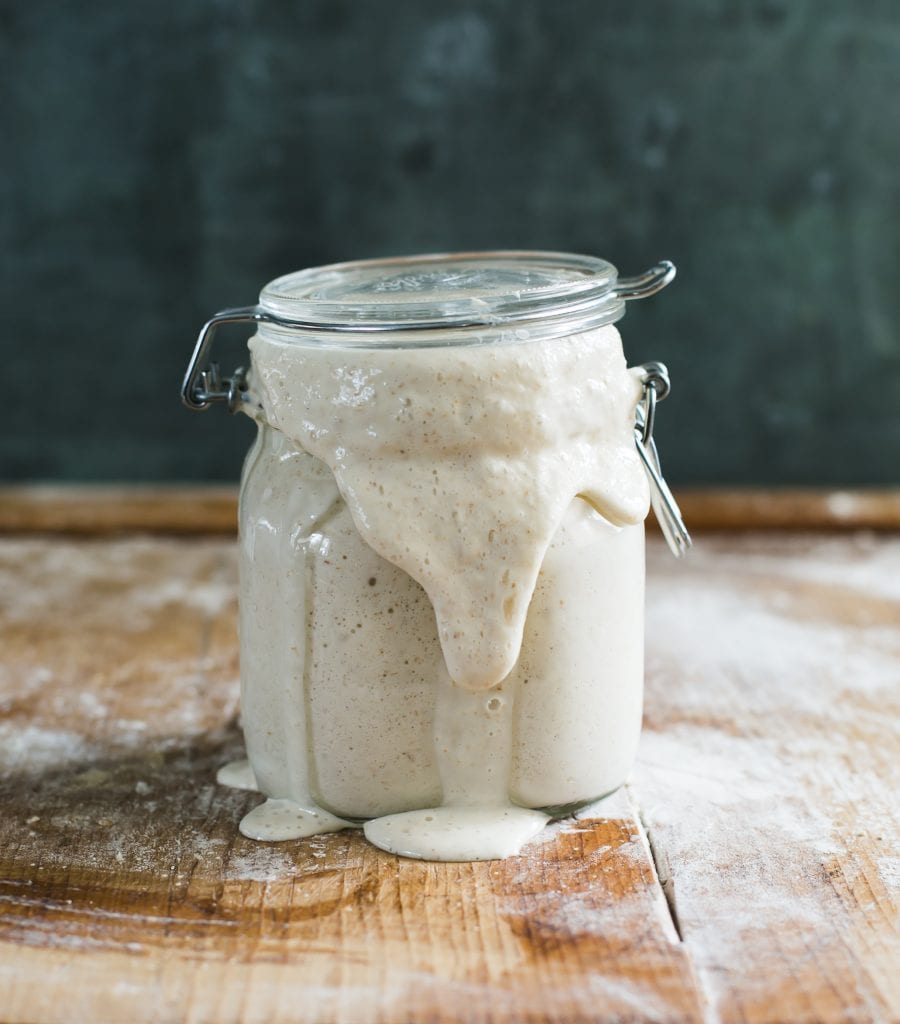
0 Response to "What Flour to Feed Sourdough Starter"
Post a Comment